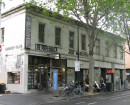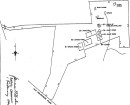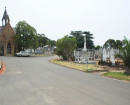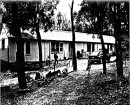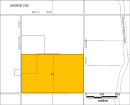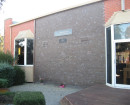Albert Park Signal Depot
Albert Road and Aughtie Road,South Melbourne, PORT PHILLIP CITY
-
Add to tour
You must log in to do that.
-
Share
-
Shortlist place
You must log in to do that.
- Download report
Statement of Significance
-
-
Albert Park Signal Depot - Physical Description 1
Located at the junction of Albert Road and Aughtie Road west of South Melbourne Cricket Club. The complex is entered from Albert Road Drive on the northern side of the complex. The complex is the last remaining example of the Inter War style employed for Defence facilities in Melbourne during the 1930s. Still under Defence management.
Interwar drill hall 1935-1939.
The essential symmetry of the central building, the drill hall, is reflected in the overall development of the site but in particular the two houses located at the front flanking corners of the irregular polygonal shaped site on Albert Rd Drive. The complex includes a range of structures that illustrate the operation of the Signals Depot. These include the drill hall (building 1), flanking houses (PMQ 13 and 14) and buildings numbers 2 and 3 incorporating garages, workshops and classrooms on the southern boundaries. Building 4, the rifle range, has been removed.
Drill Hall: the symmetry and architectural detailing of the drill hall clearly illustrates the Inter War Stripped Classsical Style of architecture. The building is in two linked parts: the smaller mess building to the street frontage with the larger drill hall behind. The two are clearly differentiated by their height and changes in materials at roof level. Single floor level with brick external walls and concrete block internal walls for economy. Timber floors. Roof over the main hall now colour bond; roof over the mess and entrance areas tiled. The front mess building comprises a central corridor providing access to the mess rooms and a suite of smaller rooms. The perimeter of the drill hall is defined by a range of smaller rooms functioning as stores and offices below high level clerestory windows. Windows metal framed.
Inter-War Stripped Classical style features include symmetrical street facade, division into bays, vestigial classical columns in the emphatic porch with capping pyramidal roof and fleche, simple surfaces with Art Deco elements expressed in horizontal string courses and brickwork detailing which creates a balance between horizontal and vertical massing and large areas of simple glazing. The central porch is flanked by inset verandah spaces opening directly onto the Sergeants and Officers messes. The Classical influences include brick columns to the verandahs, supporting parapets, expression in the brickwork of quoins, voussoirs and arches. Windows characteristically employ simple glazing bars with a horizontal emphasis. The two entrances to the depot are symmetrically located at either side of the drill hall-mess building and identified by tall symbolic brick gateposts capped by typically detailed ball finials. Gates feature Art Deco elements in the use of linear and curvillear metal forms. Side and front gates of similar design are used in both flanking PMQ houses. Side gates internal to the two house sites flanking the two entrances feature flamboyant animal designs (probably impala). A progressive yet conservative character.
Internally the drill hall features a vented ceiling with decorative plasterwork and extensive use of decorative brickwork characteristic of the Inter-War period. Internal walls are of painted finish to pointed Besser block walls. The detailing of the timberwork is consistent throughout the drill hall and mess buildings. Internal fittings in the mess building includes the original timberwork and panelling, globe light fittings and stepped ceilings with scalloped moulded joints. Fireplaces are intact and feature moulded classical, decoration, badges and over mantle fittings including shelves and light fittings.
The drill hall building includes a comprehensive range of Royal Australian Signals Corps memorabilia. These include the 1930 Corps Badge above the front entry arch, the Officers Mess badge above the fireplace, badges in the drill hall cast into the brickwork at each end of the hall, a 1935 Time Capsule in the brickwork to the right of the front entry arch and a 1960 Time Capsule buried in the brickwork at the junction of the 1935/1960 works. A cast bronze "signal depot" sign above the main entry arch was removed in 1993 and housed in the Corps Museum.
Houses PMQ 13 and 14: the architectural detailing of the drill hall is reflected in the flanking permanent married quarters (PMQs). Characteristically the two houses were constructed in red brick below red, Marseilles tiled, hipped roofs. Elements of the Inter-War style include the repetition of details used in the drill hall brickwork. Asymmetrical handed plans with hipped roofs and projecting bays. Twin external chimneys articulate the street facade which continues the horizontal expression of the drill hall mess building in the use of similar glazing and parapet feature. Chimneys capped by simple string courses reflecting the detailing of the parapet. Windows overhung sash. Detailing of brickwork uses simple polychromatic effect with alternating red and buff coursing. Windows metal framed.
Building 2: Garage Single storey brick structure of solid masonry with concrete flooring and galvanised iron gabled roof. Nine rooms.
Building 3: Lecture Room - Classrooms Single storey timber framed with 16 rooms. Gabled pitched roof. External walls galvanised iron clad. Internal walls plasterboard. Floors concrete and wood. Roof galvanised iron.
At the rear of the Depot, between the Depot and fence, is located the 15th INF Brigade Signals Section Memorial Tree and Plaque.
Location:Albert Park Signal Depot - Historical Australian Themes
Providing administrative structures and authorities - defence
Albert Park Signal Depot - Physical Conditions
All buildings in good order and well maintained. (29 April 1998). Overall the complex retains all those elements erected in 1935 with the exception of the rifle range (building 4). Horse troughs intended in 1935 were never constructed. Individual buildings have undergone the following changes. Mess building and Drill Hall: Generally intact with the following exceptions. Some walls have been removed between the smaller rooms around the drill hall to enlarge the spaces. Walls modified by the use of acoustic panels to improve the use for bands. New rear windows inserted in the rear rooms to the Drill Hall. New glass doors used internally at the entrance to the hall. Air conditioning plant installed at roof level over the smaller side rooms to the drill hall. The Drill hall has been reroofed in colorbond. Garages: extended in 1960 by the addition of a classroom wing. PMQ 13, 14: internal layouts not inspected.
Albert Park Signal Depot - Usage/Former Usage
Defence
Veterans Description for Public
Albert Park Signal Depot - Veterans Description for Public
The Albert Park Signal Depot is located on Albert Road and Aughtie Road, South Melbourne. The Depot, site for the Albert Park Barracks, was constructed pre-Federation but destroyed by fire in the 1920s. The present depot complex was purpose built for the Signal Corps in 1935, during the Inter War Years, in response to the perceived onset of the Second World War.
From 1918 to 1935 there was a sharp decline in construction but from 1935 to 1939 there was a dramatic increase in defence spending. However as the Defence Act still did not allow the existence of regular infantry all the major expenditure on accommodation in Victoria was on the construction of a series of new, imposing, red brick drill halls. The majority of designs between 1935-1939 were by Commonwealth Architect George Hallendal and displayed a high quality in design and construction.
The Depot appears to have been the first such complex constructed of brick for Defence in Victoria. The Signal Corps comprised three medium divisions; Signals 3 Aust Infantry Division, Signals 4 Aust Infantry Division, Signals Aust Infantry Division. The Signal Corps occupied the Depot from late 1935 and was joined by Area Signals in 1939. During the Second World War the depot was the signals focal point with satellite signals stations at Grosvenor, Grammar School and the 'canvas cities' in Albert and Fawkner Parks.The last signals unit left in 1975 was replaced in succession by 3OCTU, RCSC & Australian Army Band Melbourne. The complex has been extended twice with the addition of classrooms in 1960 to the garage buildings and alterations made 1992/93 to the Drill Hall for the Australian Army Band. Building 4, the Rifle Range, was demolished in 1993. The Royal Australian Army Band has been relocated with the complex now occupied by the Royal Australian Air Force Band.
-
-
-
-
-
BILTMORE (ALBERT PARK)
 Victorian Heritage Register H0475
Victorian Heritage Register H0475 -
ALBERT PARK RAILWAY STATION COMPLEX
 Victorian Heritage Register H1558
Victorian Heritage Register H1558 -
ROCHESTER TERRACE
 Victorian Heritage Register H0813
Victorian Heritage Register H0813
-
1 Fordham Court
 Yarra City
Yarra City -
10 Fordham Court
 Yarra City
Yarra City
-
-






